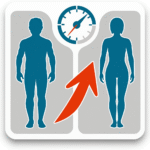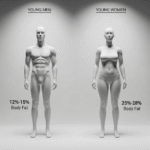Visceral fat level calculator: Discover how to measure and manage visceral fat for better health. Learn lifestyle tips to reduce risks like diabetes
Visceral Fat Level Calculator
Table of Contents
Visceral fat, stored within the abdominal cavity, poses significant health risks such as diabetes and cardiovascular disease. Understanding its implications is essential for overall health. This blog discusses the importance of measuring visceral fat, utilizing tools like the visceral fat level calculator, and implementing lifestyle changes such as a balanced diet and regular exercise—to reduce visceral fat. By recognizing the differences between visceral and subcutaneous fat individuals can take informed steps towards better health. Regular monitoring and consultations with healthcare professionals are crucial for developing effective strategies to manage visceral fat levels and enhance long-term well-being.

Introduction to Visceral Fat
Visceral fat, often referred to as intra-abdominal fat, is a type of fat that is stored within the abdominal cavity and surrounds vital organs such as the liver, pancreas, and intestines. Unlike subcutaneous fat, which is situated beneath the skin and can be pinched, visceral fat is not visible externally, making it more insidious. Understanding visceral fat is crucial, as it plays a significant role in overall health and wellness.
The presence of excess visceral fat has been linked to numerous health risks. Research indicates that individuals with high levels of visceral fat are at increased risk for metabolic disorders, including type 2 diabetes and insulin resistance. This is primarily due to the fat’s ability to release inflammatory substances and hormones that can interfere with the body’s metabolic processes. Furthermore, visceral fat is associated with a higher likelihood of cardiovascular diseases, which are among the leading causes of death globally.
In contrast, subcutaneous fat, while it can also pose health issues, generally presents a lower risk for serious health complications. Visceral fat is more metabolically active and has a stronger correlation with health problems. Consequently, monitoring visceral fat levels is crucial for assessing an individual’s health. Tools such as the visceral fat level calculator can assist in determining one’s visceral fat index, guiding them toward targeted lifestyle changes to reduce those levels.
Implementing effective strategies such as regular physical activity, a balanced diet, and stress management can significantly reduce visceral fat. Therefore, understanding the distinction between visceral and subcutaneous fat is essential in promoting a healthier lifestyle and reducing the risk of chronic health conditions related to high levels of visceral fat.
The Importance of Measuring Visceral Fat

Measuring visceral fat is crucial for maintaining overall health, given its association with several serious medical conditions. Visceral fat, which is the fat stored within the abdominal cavity, surrounds vital organs such as the liver, pancreas, and intestines. Unlike subcutaneous fat that lies just beneath the skin, visceral fat poses significant health risks. Studies indicate that high levels of visceral fat are strongly linked to increased chances of developing diabetes, heart disease, and other metabolic disorders.
A significant aspect to consider is that individuals with a normal body weight may still harbor dangerous levels of visceral fat. This phenomenon is particularly alarming, as it highlights that traditional metrics such as Body Mass Index (BMI) may not effectively indicate overall health. People who may appear fit at first glance could be suffering from a hidden risk due to their visceral fat accumulation. Therefore, it is essential to adopt a more comprehensive approach towards health assessment that includes measuring visceral fat levels.
Regular monitoring of visceral fat can encourage individuals to adopt healthier lifestyle choices, such as improved dietary habits and increased physical activity. These changes can have a profound impact on reducing visceral fat and, consequently, lowering the risk of associated health issues. Tools like the visceral fat level calculator can help individuals assess their fat levels and gain insights into their overall health status. These insights can serve as a catalyst for making informed decisions regarding health and wellness.
In conclusion, assessing visceral fat levels is critical for recognizing potential health risks and adopting preventive strategies. The importance of monitoring visceral fat cannot be overstated, as it contributes significantly to an individual’s overall well-being and longevity.
Visceral Fat Level Calculator: An Overview
The visceral fat level calculator serves as a valuable tool designed to estimate the amount of visceral fat present in an individual’s body. Visceral fat, which is located deep within the abdominal cavity, surrounds vital organs and can negatively impact health if present in excessive amounts. The calculator operates by considering several parameters, including age, gender, weight, height, and waist circumference, to provide a more accurate assessment of visceral fat levels.
To understand how the visceral fat level calculator functions, it is important to recognize the significance of the included parameters. Age and gender influence body composition and fat distribution patterns, which are critical factors in determining visceral fat levels. For instance, as individuals age, metabolism tends to slow down, which can lead to increased fat accumulation, particularly in the abdominal area. Moreover, men typically store more visceral fat than women due to differences in hormonal profiles and fat distribution patterns.
Weight and height are additional factors utilized in the calculation process. The body mass index (BMI), which is derived from weight and height measurements, provides a basic understanding of an individual’s overall body status. Waist circumference further complements this information by specifically targeting abdominal fat. An increased waist measurement may indicate higher levels of visceral fat, offering proactive insight into potential health risks.
By inputting these values into the calculator, users receive a quantifiable score that correlates with their visceral fat level. This score is instrumental in assessing personal health status and identifying risks associated with excessive visceral fat, such as cardiovascular disease, type 2 diabetes, and metabolic syndrome. Consequently, the visceral fat level calculator represents an essential component for individuals aiming to monitor their health and implement preventative measures against fat-related health complications.
Input Parameters for the Calculator
To effectively utilize the visceral fat level calculator, it is crucial to understand the specific input parameters required for accurate readings. Each variable plays a significant role in determining the overall visceral fat level, which is critical for assessing an individual’s health risk related to obesity and metabolic diseases.
The first parameter is gender, as visceral fat distribution can vary between males and females. Typically, men are more prone to accumulate visceral fat than women, particularly due to hormonal differences. Therefore, understanding gender-based differences enables the calculator to provide a more tailored assessment of visceral fat.
Age is the second input and holds substantial importance. As individuals age, there is a natural tendency for fat distribution to shift, often resulting in increased visceral fat accumulation. For instance, many adults experience changes in metabolism that can lead to higher visceral fat levels, making age an essential factor in the calculation process.
Next, weight in kilograms serves as a fundamental aspect of the calculation. Higher body weight often correlates with increased fat levels, including visceral fat. The calculator uses this parameter to quantify the amount of weight that may contribute to body fat and, specifically, the visceral fat storage.
Height in centimeters is another vital input, facilitating the calculation of body mass index (BMI). BMI is a significant indirect measure of body fat and can help assess whether an individual is underweight, normal weight, overweight, or obese. By incorporating height, the calculator can better understand how weight correlates with body fat levels.
Finally, waist circumference in centimeters is a critical parameter, as it provides a direct measurement of abdominal fat. A larger waist circumference indicates a higher amount of visceral fat, which is associated with increased health risks, including cardiovascular disease and type 2 diabetes. Together, these input parameters allow for a holistic view of visceral fat levels, aiding users in making informed health decisions.
Calculating Your Visceral Fat Level

Understanding how to calculate your visceral fat level is crucial for maintaining optimal health. The visceral fat level calculator is a straightforward tool that requires personal information for accurate results. To begin, gather the necessary details, including your gender, age, height, weight, and waist circumference. These factors are vital as they provide a comprehensive overview of your body composition.
Start by accessing a reliable visceral fat level calculator online. Most of them have a user-friendly interface, allowing you to input your data easily. Once entered, the calculator uses these inputs to analyze your body composition and estimate your visceral fat level.
After submitting your information, the calculator will generate a visceral fat level score, which usually ranges from one to 20. A score between one and five is generally considered healthy, indicating low levels of visceral fat. Scores that range from six to nine suggest moderate levels of this fat, which may require lifestyle adjustments. A score of ten or above indicates higher visceral fat levels, presenting a potential health risk. It is essential to recognize that higher visceral fat can be associated with various health issues, including cardiovascular diseases and diabetes.
After obtaining your visceral fat level, it is essential to interpret the results correctly. Consult with a healthcare professional for further insights, especially if your score falls in the higher range. They can provide personalized recommendations regarding diet, exercise, and lifestyle modifications that can help manage your visceral fat levels effectively.
By regularly calculating your visceral fat level, you can take proactive measures to enhance your overall well-being. This process not only aids in tracking your health over time but also empowers you to make informed decisions regarding your lifestyle choices.
Understanding Your Results
When analyzing visceral fat level results, it is crucial to understand the implications of each range and its impact on overall health. Visceral fat, often referred to as “hidden fat,” surrounds internal organs and can greatly influence metabolic processes. The levels of visceral fat can be categorized into healthy and unhealthy ranges, which can guide individuals in making informed lifestyle choices.
Typically, a visceral fat level of 1 to 10 is considered safe and indicative of a healthy body composition. Individuals in this range are less likely to experience potential health risks associated with excessive visceral fat, such as cardiovascular diseases, type 2 diabetes, and other metabolic disorders. Maintaining a healthy diet and regular physical activity can help preserve this level.
Conversely, a visceral fat level between 11 to 15 may signal a warning. While this range isn’t immediately alarming, it suggests the need for caution. Individuals with these levels may want to consider lifestyle modifications, such as adopting a balanced diet rich in whole foods and engaging in regular exercise to prevent progression to higher, riskier levels.
A visceral fat level exceeding 15 is a cause for concern. At this level, individuals are at a significantly higher risk of developing serious health conditions. Prolonged exposure to elevated visceral fat can lead to inflammation, insulin resistance, and increased likelihood of various chronic diseases. It becomes essential for individuals in this category to consult healthcare professionals for tailored advice on reducing visceral fat levels through effective strategies and interventions.
Understanding these levels allows individuals to take action towards improving their health. Regular monitoring and awareness of visceral fat levels can lead to proactive measures, ultimately fostering better well-being and quality of life. Making informed choices based on these results can pave the way to a healthier future.
Lifestyle Changes to Reduce Visceral Fat
Reducing visceral fat is essential for improving overall health and lowering the risk of various conditions such as heart disease and type 2 diabetes. Implementing lifestyle changes can significantly impact visceral fat levels. One of the most effective strategies involves optimizing diet. A balanced nutrition plan rich in whole grains, lean proteins, healthy fats, and an abundance of fruits and vegetables can help manage and diminish visceral fat. It is advisable to limit refined sugars, processed foods, and trans fats, as these contribute to fat accumulation around the abdominal area.
In addition to dietary adjustments, physical activity plays a crucial role in reducing visceral fat. Engaging in regular exercise, particularly aerobic activities such as brisk walking, running, or cycling, has been shown to be effective in targeting fat stores. The American Heart Association suggests at least 150 minutes of moderate-intensity aerobic activity or 75 minutes of more vigorous exercise per week, complemented by strength training at least twice a week. Integrating these forms of exercise into daily routines can accelerate the reduction of visceral fat levels.
Moreover, improving overall wellness is vital. Stress management techniques such as mindfulness, meditation, and adequate sleep can lower cortisol levels, which is linked to fat accumulation in the abdominal region. Ensuring at least 7-8 hours of quality sleep each night is essential for hormonal balance and carbohydrate metabolism, which are crucial in managing visceral fat.
Combining these lifestyle modifications not only helps in reducing visceral fat but also promotes a healthier lifestyle overall. Small, sustainable changes in diet and exercise habits, along with an emphasis on mental and emotional wellbeing, can create a long-term impact on visceral fat levels and enhance overall health outcomes.
The Role of Gender and Age in Visceral Fat Levels
Visceral fat, the type of fat stored around vital organs, poses significant health risks, including cardiovascular disease and type 2 diabetes. The distribution and accumulation of this fat can vary greatly among individuals, influenced by factors such as age and gender. Understanding these differences is crucial for effectively managing visceral fat levels and, by extension, overall health.
Age plays a vital role in determining the amount of visceral fat individuals may carry. As people age, metabolic rates typically decline, leading to shifts in body composition. This decline often results in increased visceral fat storage, particularly if physical activity levels decrease and caloric intake remains the same. In both men and women, hormonal changes associated with aging such as a decrease in testosterone or estrogen—can further impact fat distribution. For instance, men may experience an increase in abdominal fat due to lower testosterone levels, while women often see a redistribution of fat during menopause, leading to higher abdominal fat levels. These age-related factors are crucial for anyone looking to evaluate their visceral fat through a calculator.
Gender differences also significantly influence visceral fat levels. Research shows that men generally have a greater propensity to accumulate visceral fat compared to women. This discrepancy is largely attributed to hormonal differences—with estrogen in women promoting fat storage in the hips and thighs, while testosterone in men facilitates fat deposition in the abdominal area. Additionally, women typically experience a protective effect against visceral fat accumulation until menopause, after which they may notice an increase in abdominal fat. The visceral fat level calculator accounts for these differences as it provides a more accurate health assessment, considering hormonal influences alongside age demographics.
Conclusion: Taking Control of Your Health
In reviewing the significant aspects of visceral fat, it becomes apparent that understanding and monitoring this form of fat is essential for maintaining optimal health. High levels of visceral fat, located deep within the abdominal cavity and surrounding vital organs, are linked to various health risks, including cardiovascular disease, diabetes, and metabolic syndrome. The visceral fat level calculator serves as a valuable tool for individuals who want to assess their fat levels effectively and take proactive health measures.
Cognizance of visceral fat levels should not be limited to mere awareness; it should spur individuals to make informed lifestyle choices. Creating a balanced diet, engaging in regular physical activity, and managing stress are pivotal steps toward reducing visceral fat. It is crucial to recognize that each individual’s body responds differently to these changes, and adopting a sustainable approach, rather than pursuing rapid weight loss, often yields more effective long-term results. Furthermore, regular monitoring through methods such as waist circumference measurements or utilizing a visceral fat level calculator can help track progress and motivate continual improvement.
Moreover, consulting healthcare professionals for personalized advice and support can enhance one’s health journey. This tailored approach not only aids in addressing existing conditions but also empowers individuals to foster habits that maintain healthy visceral fat levels over time. Embracing this knowledge, coupled with practical steps to take control of health, can significantly diminish the risks associated with excess visceral fat.
In conclusion, remaining proactive in monitoring visceral fat levels is indispensable for one’s health regimen. By leveraging resources like the visceral fat level calculator, engaging in healthy lifestyle practices, and seeking professional guidance, individuals can effectively manage their visceral fat and, subsequently, their overall health.









